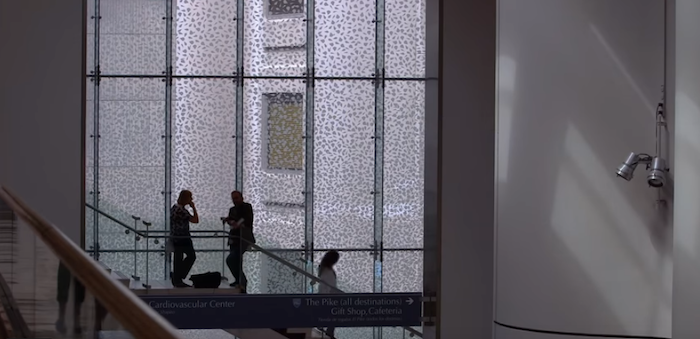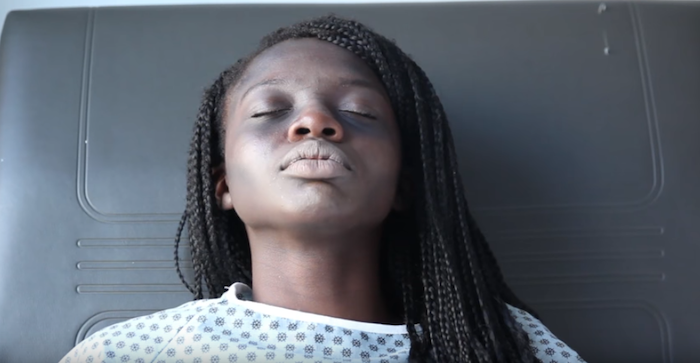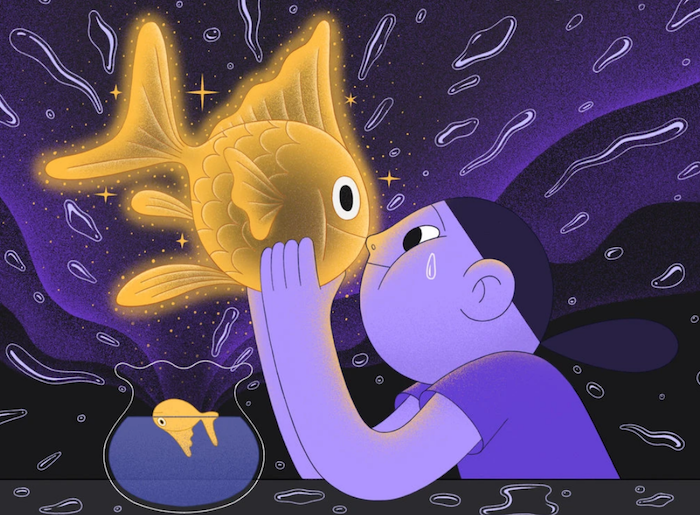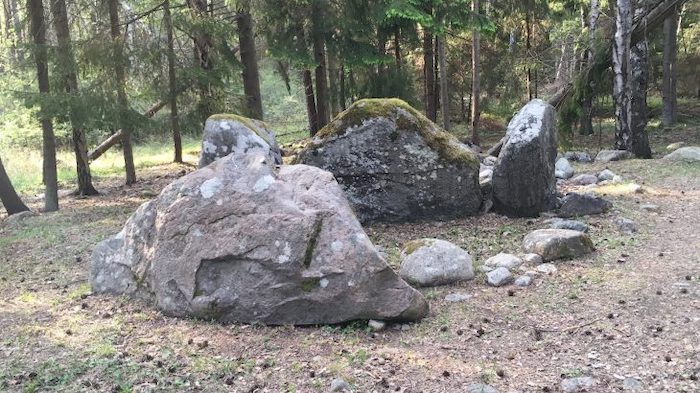How Expensive Is It To Die?
Why Do 4-Year-Olds Love Talking About Death?
When our older daughter was 4, it seemed like she was asking us about death constantly. These questions were apropos of nothing; we hadn’t had a death in the family or lost a pet. What was jarring was her matter-of-fact tone. We’d be sitting at dinner and she’d ask a barrage of questions in a completely neutral voice: “When are you going to die? Is Grandma going to die first because she’s old?” And on and on. I tried to calmly match her tone and answer her honestly, but sometimes you just want to eat your salad without contemplating your own mortality.
At the time, I was slightly worried that there was something wrong with her — at best she was a proto-goth who would be really into the Cure as a teenager; and at worst, her questions meant she had some troubling anxiety that was emerging through a fixation on death. But when I started talking to other parents, I learned that their preschoolers were also asking tons of questions about death at awkward moments.
A lot of parenting questions boil down to: Is this a thing, or is something wrong? So I decided to start an occasional series explaining why certain things seem to happen to your kid (or to your body or your relationships) as your child grows. For this edition, I asked three psychologists, two of whom have done research on children and their understanding of death, about why preschoolers ask a lot of questions about death, and how to best answer them. If you have a question for a future “Is this a thing?” newsletter, email me here.
Why do kids start asking about death in preschool?
Preschool is the age of “why” in general, said Dr. Lauren Knickerbocker, Ph.D., a child psychologist at N.Y.U. Langone’s Child Study Center. And what adults sometimes don’t realize, because we’re inured to it, is that our kids are surrounded by death all the time: Cartoon characters die, the leaves on the trees die, an ant they smushed at the playground is dead.
Because they’re already so curious about the world, they see our reactions to their questions about death — our faces may blanch — and they pick up on that and want to dig deeper.
What do they understand about death at 4?
There are four subconcepts of death that psychologists have identified, explained Dr. Sally Beville Hunter, Ph.D., a clinical assistant professor at University of Tennessee, Knoxville: nonfunctionality (your body doesn’t work anymore), universality (all living things die), irreversibility (once you die, you can’t come back to life) and inevitability (you can’t avoid death).
Though children pick up these concepts at different ages, depending on their cognitive abilities and their life experiences, at 4, the subconcept they tend to understand first is nonfunctionality, Beville Hunter said. Because it’s straightforward, many preschoolers can understand that when you’re dead, your arms and legs don’t move anymore, and your heart stops beating.
“We’re all gonna die” is something that’s a bit harder for a 4-year-old (or let’s be honest, a 37-year-old) to fully internalize. But according to Beville Hunter, many kids will understand all four subconcepts somewhere in the 7-10 age range.
How do I answer their many, many questions about death?
Do not use euphemisms. Children in the 3-6 age range have very concrete thinking, said Dr. Dunya Poltorak, a pediatric medical psychologist in private practice in Birmingham, Mich. If you say something like, “Grandpa passed away” instead of “died,” it may confuse your child. She may think, “Did they go away somewhere? Are they on a trip? Did they pass over the border into Canada? It can just potentially risk greater confusion and lack of understanding,” said Poltorak. So use the term “died,” even if it feels harsh.
Try to respond simply and clearly. Don’t brush off their questions even if they make you uncomfortable, said Poltorak. And you don’t need to get into too much detail with kids this age, said Beville Hunter. So for example, if your child asks you, “When are you going to die?” You can say, “I try to take very good care of myself and to be careful and plan to live a very long time until I’m quite old,” Poltorak suggested. If kids have follow-up questions, they will ask.
If your kids are endlessly curious about death in a nonanxious way, you can take them on a tour of a cemetery, Beville Hunter suggested. It’s something she did with her own children. “We went around and read the names on the gravestones, we did etchings, we looked at the numbers and talked about the age they were when they died,” Beville Hunter said. It opens up a space for your kids to get answers to many of their pressing questions.
If a kid is anxious about death, “I would assure them of safety, health and everything within your family dynamic, then I would try to redirect from there,” said Poltorak. Try classic distraction after addressing their questions clearly — let’s go paint! Or, why don’t we read a book? If a kid is really ruminating and you’re concerned because his anxiety is affecting his quality of life, talk to your pediatrician. Your child’s doctor may recommend a pediatric psychologist. “It’s always good to intervene young when children have anxiety,” Poltorak said.
When you have a death in the family, Knickerbocker and Poltorak both recommend that grieving children memorialize loved ones with art projects. They emphasized the concreteness of preschoolers’ thinking, so having something to work on like a scrapbook of memories of that person is helpful.
If your religious beliefs include an afterlife or resurrection like in the Easter narrative, again, try to address any questions straightforwardly. You don’t need to overexplain or answer questions that weren’t asked, said Beville Hunter. Poltorak, who is Catholic, said she talks to her children about heaven and tries to keep it light. Her father, who was very close to her children, died recently. He used to bring candy over to their house all the time, so Poltorak tells them, “Grandpa is probably up in heaven giving Jesus cavities.”
Complete Article ↪HERE↩!
Families in Europe were buried together during the Stone Age
An international research team led by Uppsala University has discovered that individuals buried in megalithic tombs in Ireland and Sweden during the Stone Age were relatives. The families can be traced for more than ten generations, which indicates that megaliths were graves for kindred groups in northwestern Europe.
Beginning around 4,500 BCE, megalithic monuments emerged along the Atlantic European shoreline that were often used for funeral practices. However, the social structure and origin of the groups that began constructing the stone monuments remains a mystery.
For the current study, the researchers sequenced and analyzed the genomes of 24 individuals recovered at five megalithic burial sites, representing megalithic construction in northern and western Europe.
By using radiocarbon-dating, the team traced the remains back to between 3,800 and 2,600 BCE. Genome sequencing revealed that the individuals in the megaliths were closely related to Neolithic farmers in northern and western Europe, but not closely related to farmers in central Europe. On the British Isles, the males in the tomb outnumbered the females.
“We found paternal continuity through time, including the same Y-chromosome haplotypes reoccurring over and over again,” said study co-author Helena Malmström. “However, female kindred members were not excluded from the megalith burials as three of the six kinship relationships in these megaliths involved females.”
The genetic analysis showed close family ties among the individuals buried within the megaliths. In two particular tombs that were located about two kilometers away from each other, it appeared that parents were buried together with their offspring. “This came as a surprise. It appears as these Neolithic societies were tightly knit with very close kin relations across burial sites,” said co-author Federico Sanchez-Quinto.
The Ansarve site on the island of Gotland in the Baltic Sea is located in an area that was home to mostly hunter-gathers.

“The people buried in the Ansarve tomb are remarkably different on a genetic level compared to the contemporaneous individuals excavated from hunter-gather-contexts, showing that the burial tradition in this megalithic tomb, which lasted for over 700 years, was performed by distinct groups with roots in the European Neolithic expansion,” explained study co-author Magdalena Fraser.
“That we find distinct paternal lineages among the people in the megaliths, an overrepresentation of males in some tombs, and the clear kindred relationships point to towards the individuals being part of a patrilineal segment of the society rather than representing a random sample from a larger Neolithic farmer community,” said study senior author Mattias Jakobsson.
“Our study demonstrates the potential in archaeogenetics to not only reveal large-scale migrations, but also inform about Stone Age societies and the role of particular phenomena in those times such as the megalith phenomena,” concluded Sanchez-Quinto.
Complete Article ↪HERE↩!
From diamonds to rockets, mourning the dead has gotten high-tech
In the 21st century, people have a widening range of options for preserving loved ones’ ashes.

By Glenn McDonald
Throughout history, people have devised elaborate ways to memorialize the dead: the pyramids of Egypt, Europe’s Gothic mausoleums, the Taj Mahal in India. What some mourners consider meaningful, others would call macabre. In 19th-century Europe and America, “death photography” produced portraits of the departed in lifelike poses; in the Tibetan Buddhist rite known as sky burial or bya gtor (alms for the birds), earthly remains are set out to feed vultures.
Notions about honoring the dead are shaped by many factors—culture, tradition, geography, religion. But the notion is one thing, and the execution is another. In every era, it’s the available technology that determines our range of memorial options.
The intersections of death and technology have long been busy crossroads. In these early years of the 21st century, they’re getting really interesting. Because I write about science and technology for a living, I’ve lingered at these intersections, observing the innovations: digital memorials on social media, eco-friendly green burial options, even interactive tombstones.
Among the tech-savvy options for modern decedents, one stands out because it’s so genuinely weird. Thanks to startling advances in industrial engineering, we can now synthetically re-create colossal geological forces to shape our ultimate destiny on this planet. It’s gratuitous and extreme and wonderful: We can turn our mortal remains into diamonds. Real diamonds.
Several companies worldwide now offer services to families that have the notion, and the resources, to memorialize their loved ones in arguably the most permanent way possible. The Swiss company Algordanza is one of them.
Using high-tech heavy-industry machines, engineers can transform the carbon from human ashes into diamond gems that are physically and chemically identical to natural diamonds. The geologic process that otherwise takes hundreds of millions of years can now be managed in weeks.
It works like this: After the cremation, the bereaved family ships one pound of ashes to Algordanza’s laboratory in Switzerland. Scientists process the ashes to extract the pure carbon elements and remove other impurities. (The remaining ashes are shipped back.) From there, Algordanza uses the same tools Mother Nature uses to make diamonds: heat and pressure.
In the next step, the carbon ashes are converted into graphite, a stable allotrope of carbon in which the atoms are packed into tight, flat sheets. Then the carbon settles down for a long bake inside Algordanza’s high-pressure, high-temperature (HPHT) machines. Temperatures rise as high as about 2,400 degrees Fahrenheit. For comparison, consider that cast iron melts at about 2,200 degrees Fahrenheit.
Then there’s the pressure. Within the HPHT machine, a system of cubic presses exerts a force of 870,000 pounds per square inch on the graphite, gradually changing the molecular structure and transforming the carbon into pure diamond.
To be clear, these diamonds aren’t just similar to a natural diamond; they are identical down to the atomic level. The gem that emerges can be kept in its rough state or cut and polished by Algordanza’s specialists.
The entire operation—from initial receipt of ashes to final delivery of the diamond—typically takes five to eight months. The company processes approximately 1,000 memorial diamonds a year and has representatives in 34 countries.
Algordanza offers packages with prices starting at about $3,000, says Christina Martoia, its U.S. representative. About that pricing—perhaps it’s impolite to ask, but we all want to know, right?
“The largest Algordanza memorial diamond produced to date was a 1.76-carat brilliant cut,” Martoia says. “The price was $38,000.”
While the hard science of memorial diamonds is fascinating—a billion years in a matter of weeks!—the price may be out of reach for us budget-minded afterlife planners. Death is already mandatory and largely unpleasant. Does it have to be expensive too?
Happily, another company has stepped into this odd little marketplace. Headquartered in Barcelona, the Spanish start-up Bios Urn offers a much more affordable high-tech memorial option.
By way of a smartphone app and a kind of interactive funeral urn, the Bios system lets grieving families turn their departed loved one into an indoor tree for their home. A capsule of cremains is bedded in a large pot, in which a seedling is planted. As the seedling grows, it sends roots into the cremains, and the Bios Incube automatically waters and cares for the memorial sapling. Built-in sensors monitor temperature, humidity, and soil conditions. Information beamed to the smartphone allows the family to nurture the sapling as it grows into a tree.
The company offers two versions. One provides the basic biodegradable urn and planter for $145. The more expensive version, incorporating the sensors and the app, is around $700. I could swing that, and I kind of like the idea of making my kids take care of me through my oaken golden years.
Will bytes replace gravestones?
A historian asks how we’ll mark death and memorialize loved ones in a digital future.

Katie Thornton has been thinking quite a bit about death. For the past few years, the cemetery historian has examined epitaphs and researched the “residents” buried at Lakewood Cemetery in her hometown of Minneapolis, with the goal of preserving stories for posterity. “A lot is at stake right now,” says the Fulbright-National Geographic digital storytelling fellow. Around the world, people are questioning whether cemeteries are a sustainable use of scarce land. “Without planning, the stories buried at cemeteries could be lost forever,” Thornton says—but technology may offer a solution. Thornton is launching a podcast, Death in the Digital Age, to explore how global urbanization and the rise of digital documentation are changing conventions for memorializing the dead, especially in England and Singapore. Thornton discusses her work on National Geographic’s Open Explorer platform. —Annie Roth
Candi K. Cann is one of the world’s leading experts on modern mourning. She teaches comparative religion at Baylor University in Texas and is the author of the book Virtual Afterlives: Grieving the Dead in the Twenty-First Century. She says that as a mourning custom, memorial diamonds and smart urns are really just modern iterations of much older cultural traditions. Both are associated with the psychological concept of continuing bonds.
The idea is that keeping the decedent in one’s life, in some form, is healthier than the detachment of, for instance, putting Dad six feet under. The diamond or the urn reflects “the need for continued rituals that incorporate and acknowledge the role of the loss of the deceased person,” Cann says. “It allows the living to grieve without being forced to ‘move on’ or forget the dead.”
If you’re interested in going down this particular rabbit hole, Cann suggests looking into the strange beauty of Victorian mourning jewelry. “The bereaved would take a lock of the decedent’s hair and turn it into wearable and functional jewelry,” she says. “Often the hair was woven into an intricate design and turned into a ring, a brooch, or a pin. Only the bereaved knew the origins of the hair.”
Cann says such jewelry is meant to serve the same function as today’s diamond or interactive urn—or yesteryear’s death photography, for that matter. It’s about people turning to the technology of their era to navigate death and dying. The Romans did it. The Persians did it. The Maya did it. We’re doing it with delicate microchips and massive machines. The technologies change, but the basic human experience remains.
Since I have some time (I hope), I plan to postpone any decisions until I’ve surveyed all my 21st-century options. Right now I’m leaning toward the tree. It’s more cheerful, and I’ve always admired the sedentary style of flora as a lifestyle choice.
Besides, that diamond thing seems like a lot of pressure.
Complete Article ↪HERE↩!
‘Soul midwife’ offers companionship to the dying in their final moments
Linda Jane McCurrach is an end-of-life doula – a non-medical, holistic companion who guides and helps people to have a gentle and tranquil death.
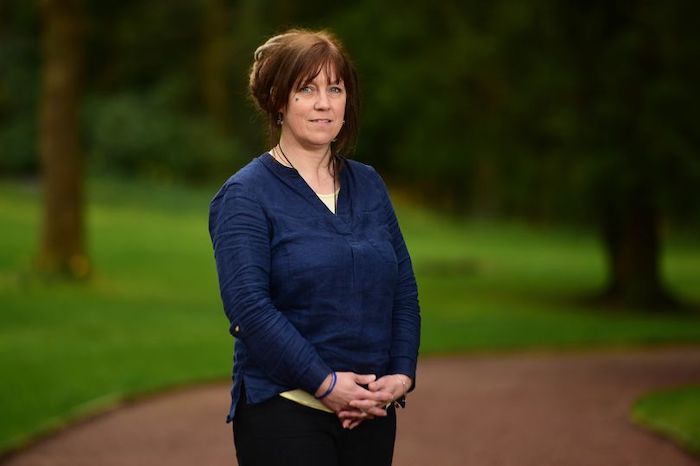
By Maria Croce
Midwives are associated with helping to bring new life into the world. But there’s another type who are there at the end, when people are dying.
Linda Jane McCurrach is a “soul midwife” or end-of-life doula – a non-medical, holistic companion who guides and supports the dying to help them have a gentle and tranquil death.
She describes the people she supports as friends and says it’s about helping them have a “good” death. But she admits some people initially find it difficult to grasp the idea that there can be a positive side to something so finite.
Linda Jane added: “People don’t even want to think about having a good death because they can’t imagine dying.
“But in eastern culture, they believe that only by looking at our death can we live fully.”
She sees some parallels between conventional midwives who bring new life into the world and her role for the souls who are leaving.

She said: “I couldn’t imagine my mum not having someone there. I thought, ‘What would it be like for someone to be on their own?’ It really struck home that I can help people going through this alone.”
Linda Jane has now launched a charity called No One Dies Alone Ayrshire.
For those who are alone, it aims to provide companions in the last 48 hours of life. It also offers respite for those with families.
Companions will offer support at home, in care homes, in hospital and hospices and will enable people to die according to their wishes.
The charity has started its work in East Ayrshire with plans to expand into the rest of the county.
Linda Jane, 48, has five children – Jordan, 23, Lewis, 22, Kai, 17, Nathan, 15 and Freya, eight – and lives near Newmilns in Ayrshire.
Having had difficult experiences and relationship break-ups, she said death puts everything else into perspective.
She added: “You have a greater sense of what’s important.”
The hardest part of her role is when people open up to her in their final days.
She said: “It can be hard to then move back into a normal life. But I surround myself with the right people who help me with that.”
She remembers the first time she sat with someone who was dying.
Linda Jane said: “I was concerned with doing everything right. It wasn’t until the end I realised it’s not really about the stuff you know and the things you can do, it’s about being there.
“Death is individual. It’s not scary. But if the person is feeling a bit scared, you can be a loving presence to help them get through.”
She said the dying want to know what’s happening to them.
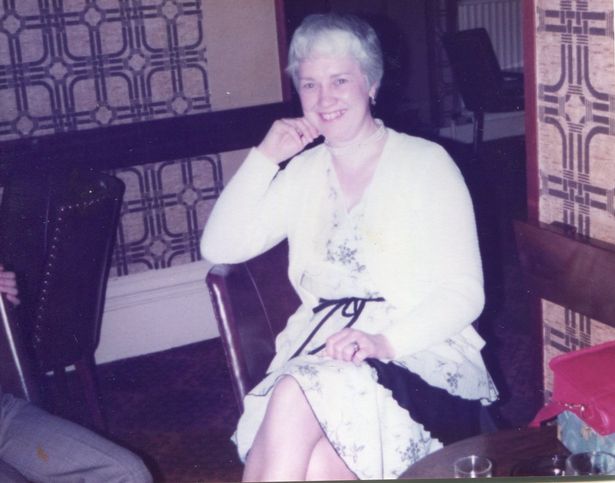
Linda Jane added: “People want to know the process. It’s not commonly spoken about.”
She also helps them make peace with the world.
“Ultimately, death is the major letting go in our lives,” she said. “We have to let go of everything and it starts with letting go of the past.
“Sometimes they need to get things off their chest or make amends with family members and things weighing heavily with them.
“And everybody wants to know where they’re going to go afterwards. Having a visualisation of somewhere they would like to go really helps with that, for instance a meadow full of bluebells.”
Although she’s less scared of dying herself now, Linda Jane said she wouldn’t want to leave her children yet.
She added: “I think hopefully by the time I die, I’ll be ready. I know death can be positive and beautiful.”
Complete Article ↪HERE↩!
Review: The Art of Dying Well – A Practical Guide to a Good End of Life
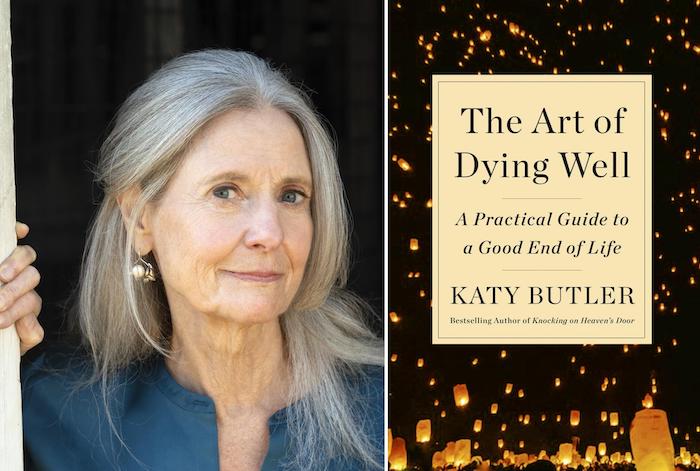
By Trish Rodriguez*
I have to confess that I am a Katy Butler fan. When I started the journey to become an End of Life Doula, her Knocking on Heaven’s Door was one of the first books that I read. I didn’t so much read the book as devoured it, often catching a sob in my throat as I read her deeply personal account of the horror show that became her fathers final years. I admired the courage and honesty of the parts of the book that were memoir, and the research on the current culture of American healthcare with respect to death. I agreed that our way of dying in the good ol’ USA has come to leave something to be desired.
In her newest work The Art of Dying Well – A Practical Guide to a Good End of Life, Katy picks up the narrative in a new and accessible way. She divides the process of moving toward the end into seven unique segments defined not so much by age but by ability and functionality. At the beginning of each of these chapters she has a list of statements and suggests that if many of these apply to you now, this might be where you find yourself. I found this approach fresh and, best of all, non-threatening. This might be just the way to start a conversation with a unwilling family member.
In the first segment, aptly titled Resilience, we learn that in this stage of well being we can still dramatically impact our health, longevity, and ultimately the quality of our death. By building reserves (aka altering what we eat and whether we’re active enough), finding allies in preventative medicine, and increasing our circle of friends and acquaintances, we are still in the drivers seat with regard to how things will go for us as our situation changes. This perspective gives lots of practical advice for those who may think there is plenty of time.
With each ongoing chapter comes an inevitable decline – not according to any decade of life or disease process – but according to naturally decreasing functionality. I like that she is careful to follow this definition, as people age as they darn well please, and I personally know 90 year olds who are still more capable than I am. This lets you find your home page, so to speak, without feeling like a failure or self fulfilling a prophecy to act your age. Every chapter offers practical advice; about healthcare, money, housing, and all those pesky details like advanced directives and wills. In nearly every chapter there are personal accounts of folks who managed things well, or not so well, and lots of food for thought.
There was a great deal of material that wasn’t new to me, but I work with dying people. In my every day life, I am always shocked at how hard working, responsible people don’t bother with a will or advanced directive… because? They aren’t going to die? Or they’re not going to die tomorrow? This book may be just the ticket to get you going, or to give to that parent who is dragging their feet about preparing for anything. With a helpful glossary and pages and pages of useful references included, this will certainly be a ‘go to’ book in my personal library and in my practice.
* Special correspondent, Trish Rodriguez, is an End of Life Doula and hospice vigil volunteer in Anacortes, WA.

